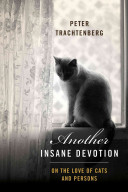283 pages, $24
Review by Erin Hutton
Framed by Peter Trachtenberg’s journey to locate his beloved cat Biscuit, Another Insane Devotion: On the Love of Cats and Persons, is a memoir of love stories braided with historic notes on the bonds between humans and cats. This is a book for anyone who has ever let a cat outside and later discovered it has disappeared. It is for anyone who has loved (and lost) a cat. And perhaps even for those who don’t understand what it is cat lovers love about cats, but who want to learn.
When Trachtenberg took a temporary job in North Carolina and his wife, F., was at an artists’ residency in Europe, the couple left their home in New York and their cats in the care of Bruno, who Trachtenberg refers to as a “kid” and “useless as a cat-sitter.” Bruno’s uselessness rose to Trachtenberg’s attention when Bruno called to inform him that their orange cat had been missing for three days. After hearing the news, Trachtenberg purchased a plane ticket to go home and look for the cat, who was not so much orange as golden, biscuit-colored, like her name.
Trachtenberg reflects on his decision to travel in search of Biscuit: “I was half convinced that Biscuit was dead and half convinced that even if she was alive, she was unlikely to be anyplace where I could find her. I didn’t want to spend money I didn’t have traveling seven hundred miles to have my heart broken searching for a cat I wouldn’t find. And yet I did. I went. What was I thinking?”
The first potential answer to this question comes in the form of emails he sent to F. and friends before traveling north to look for Biscuit: “‘I don’t know if my being there will accomplish anything,’ I wrote F. ‘By that time she’ll have been gone 5 or 6 days,’” To another friend he wrote: “I just know I won’t be able to rest until we find her or are convinced she’s dead, and I’d rather be up there doing something than sitting her brooding and cursing.”
Trachtenberg is far from the first person to show such devotion for a feline. He cites an example of a man buried with a cat: “Some 9,500 years ago, on the island of Cyprus, in a village called Shillourokambos, a man was buried beside a cat. A team of French archaeologists unearthed their bodies in 2001. Both sets of remains were well preserved, and although each had a separate grave, these were only sixteen inches apart and had been dug at the same time. … While a nearby grave pit contained parts of several animals, the cat had been buried whole and intact in a way the scientists believed called attention to it as an individual. This creature and not another. With this man.”
Trachtenberg’s continued attempt to answer the question “What was I thinking?” through this book is not only an account of his search for Biscuit, but a journey through the lives of Trachtenberg’s other cats, their relationships with each other as well as with Trachtenberg and F., and a reflection on a difficult time in his marriage to F. Trachtenberg reveals many intimate details about his marriage, but he keeps the reader at a distance by referring to his wife only as F. However, he gives the name of each cat in full and by doing so allows readers to love them whole-heartedly, as he does and as the cats may love each other.
When Trachtenberg’s cat Bitey is dying in their bathtub at home, we see the love and devotion that Trachtenberg has for Bitey, but also the sweetness of his marriage to F. and the depth of the relationship between his cats Bitey and Suki. While there is little scientific evidence about feline emotion, one can’t help but feel love between Bitey and Suki. Trachtenberg, F., and Suki all stay with Bitey during the cat’s final hours, and at one point F. softly points out that Suki’s eyes were filled with liquid: “The liquid was clear and bright, and it ran down the gray tabby’s cheeks, and I don’t think it’s too great a stretch to call it tears. They may or may not have been tears of grief.”
Trachtenberg’s devotion to and delight in cats, love, and his marriage never wavers. He invites us to meander through early records of domestic cats, follow the crushing story of F.’s Italian cat Gattino, understand the meanings behind the noises cats make, spend time with thoughts on love from Proust, consider the difficulty of writing about cats as opposed to dogs, and more. There are so many little pieces in this book it’s nearly impossible to summarize. Yet, all the while the return to Biscuit’s story is what keeps the pages turning.
At the peak of Gattino’s story, woven into the peak of Biscuit’s story, Trachtenberg comes to a truth both gut-wrenching and somehow comforting that I’m tempted to share here. I especially want to share it for those who have, like me, arrived at the understanding that a beloved indoor/outdoor cat, who loved the outdoors and brought home many dead mice, voles, chipmunks, and, once, half a weasel, has likely fallen prey to a larger foe. But this truth is best arrived at where Trachtenberg put it, very near the end of the book, after you know of his cats Biscuit and Bitey, Gattino and Suki, and others. So why not curl up with your favorite feline – or your curiosities about them – and explore these truths together?
***
Erin Hutton is the Program Assistant for the Master of Fine Arts in Creative Writing at Chatham University and is a graduate of the program. Her work has appeared in The Inquisitive Eater, Blood and Thunder, and i ran, and Ophelia Street. She blogs at Don’t Forget to Eat!
![[PANK]](https://pankmagazine.com/wp-content/themes/pank/assets/images/pank-logo-large.png)

